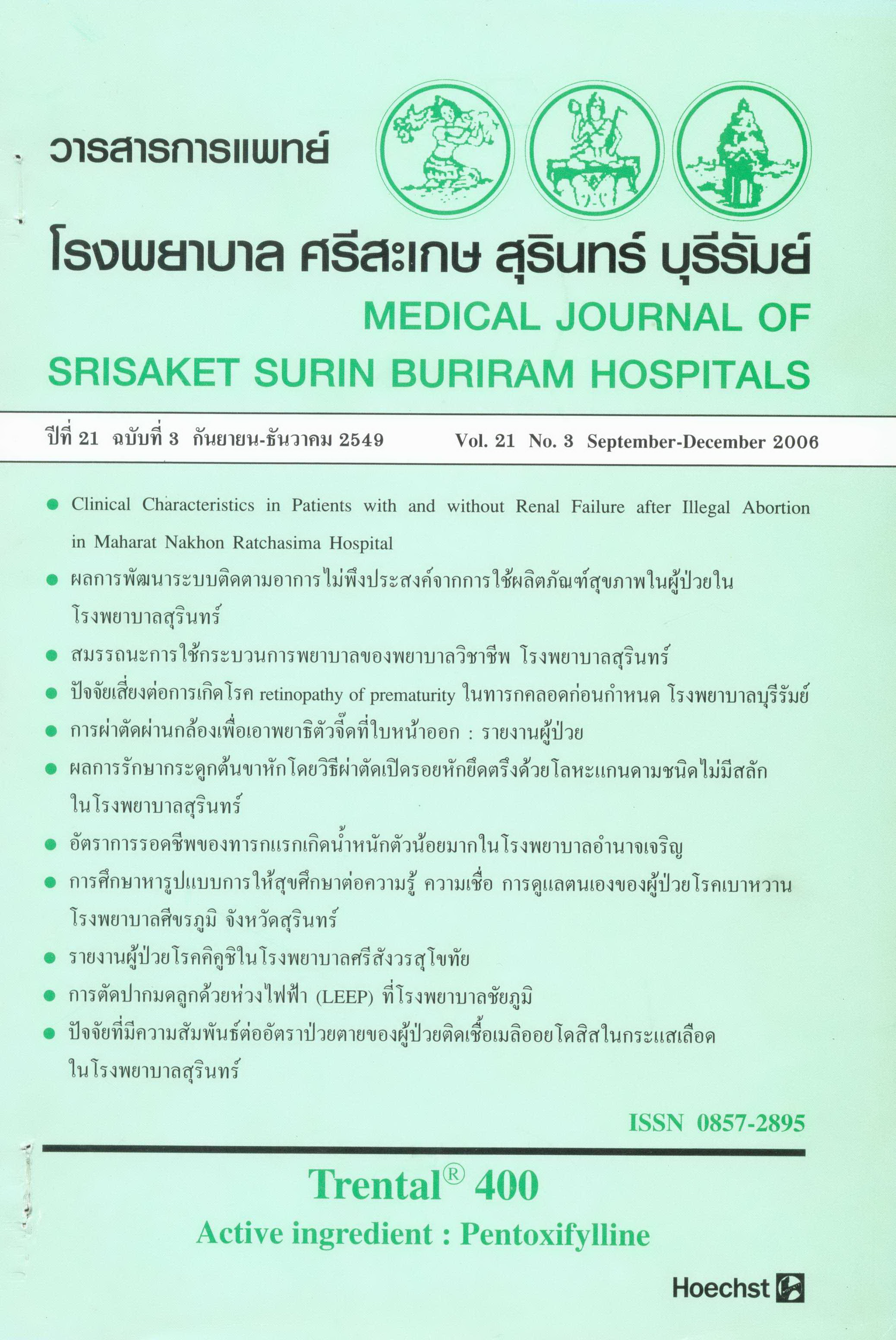Clinical Characteristics in Patients with and without Renal Failure after Illegal Abortion in Maharat Nakhon Ratchasima Hospital
Main Article Content
บทคัดย่อ
Problem: Renal failure is the serious complication in illegal abortion. There were very few reports on its incidence and none of the reports had studied on the difference of the clinical characteristic, treatment methods, treatment outcomes and the prognosis.
Objective: To study on the incidence, clinical characteristics of acute renal failure after illegal abortion, and the difference in clinical characteristic in patients with and without this complication in Maharat Nakhon Ratchasima Hospital.
Study design: Historical cohort study
Setting: Department of Obstetric and Gynecology and Family planning, Maharat Nakhon Ratchasima Hospital.(MNH)
Material: 247 cases of illegal abortion that had been admitted from 1 January 2000 to 31 December 2004 were included into the study.
Methods: Data were collected from the inpatient medical records, reanalyzed and filled into the Microsoft excel. Statistic analysis was done by using standard program. Statistic methods were Percentage, Chi-square, T-test.
Results: The incidence of illegal abortion was 16.56% of all abortion. Mostly were found in patients between 20-29 and < 20 years of age which were 50.61% and 35.22% respectively. Employees were found 35.77%. Students were found 34.15%. The median gestational age was 13.8 weeks. 88.64% of the abortions were not done by medical doctors. Injection of solutions into uterine cavity was used in 57.89% of cases. Complications that were recorded were septic abortion (221 cases, 94.85%), blood transfusion (55 cases, 22.36%), ICU admission (3 cases, 1.21%), emergency surgical treatment (10 cases, 4.05%), renal failure (32 cases, 13%), and death (1 case, 0.40%). Positive vaginal swab cultures were found in 23 cases (48.93%) and positive hemocultures were found in 15 cases (24.59%)
Acute renal failure was found in 32(13%) cases. Conservative treatment was implemented in 29 cases (90.63%). Eight cases(25%) needed hemodialysis or peritoneal dialysis. Others had self-resolution. When compared clinical characteristic between cases with ARF and non-ARF, the study found that the mean age, number of parity, referral cases, injection of solutions into intrauterine cavity, the number of days of fever prior to admission, the duration of treatments and the mortality were much more than non-ARF group with significant.
Conclusion: The incidence of illegal abortion in Maharat Nakhon Ratchasima Hospital was 16.5%. Renal failure was found in 13% of cases and most cases were not associated with severe infection. Conservative treatment was implemented in 90.63% of cases and only 25% of acute renal failure needs hemodialysis or peritoneal dialysis. 1 case was dead from sepsis and acute renal failure.
Key words: Criminal abortion, septic abortion, acute renal failure, conservative treatment
Article Details
เอกสารอ้างอิง
2. Hakim-Elahi E, Tovell HMM, Burnhill MS.O bstet Gynecol 1990;76:129-35.
3. Council on Scientific Affairs, American Medical Association. Induced termination of pregnancy before and after Roe V Wade: trends in the mortality and morbidity of women. JAMA 1992;268 :3231-9.
4. Stubblefield PG.Family planrdng.In: Berk JS, editors. Novak’s Gynecology. 13rd ed. Baltimore : Lippincott Williams & Wilkins; 2002. p. 266-8.
5. World Health Organization(who) .Unsafe Abortion: Global and regional estimates of the incidence of unsafe abortion and associated mortality in 2000.4th ed. Geneva, Switzerland 2004.
6. Finkielman JD, De Feo FD, Heller PG, Afessa B. The clinical course of patients with septic abortion admitted to an intensive care unit. Intensive Care Med. 2004 ; 30(6):1097-102. Epub 2004(3).
7. กิ่งมณี กองเงิน, นนท์ โสวัณณะ, ปนัดดา ช่วยแก้ว, อิศราภรณ์ พลหล้า. การศึกษาแนวโน้มของการทำแท้งในระยะเวลา 4 ปี (2539-2542) ปัจจัยชักนำและทัศนคติต่อการทำแท้งของสตรีที่เข้ารับการรักษาใน โรงพยาบาลพุทธชินราช พิษณุโลก. (Medline)
8. อมร เกิดสว่าง, สุพร เกิดสว่าง, สุวนีย์ ศรีสุพรรณดิษฐ์ และคณะ ใน : สุพร เกิดสว่าง บรรณาธิการ. พิมพ์ครั้งที่ 1. กรุงเทพฯ : ธีระการพิมพ์; 2523:107-19.
9. Rerk-ngarm S, Gritiyachote S, Jariyaphan M. Analysis of Illegal abortion. 1985 Sep;10(9):629-641.
10. พิมพาพร ตันประเสริฐ. การทำแท้งผิดกฎหมาย. สารศิริราช 2525; 34(4) :212-8
11. Pongthai S, Phuapradit W. Illegally in duced abortion. J med Ass Thailand. 1984 Oct;67(S2): 50-2.
12. Sood M, Juneja Y, Goyal U. Maternal mortality and morbidity associated with clandestine abortions.J Indian Med Assoc.1995 Feb;93(2):77-9. (Medline)
13. Baxi LV, Nerurkar AS, Dsourza M, Purandare VN. Septic abortion. J Obstet Gynecol India. 1971 Dec;21(6): 655-60.(Medline)
14. Rana A, Pradhan N, Gurung G, Singh M. Induced septic abortion: A major factor in maternal mortality and morbidity. J Obstet Gynecol Res. 2004 Feb;30(l) :3-8.
15. Utian WH. The cause if death following abortion: An analysis of consecutive cases at Groote Schuur Hospital. J Obstet Gynecol Br Commonw. 1968 Jul;75(7):705-12.
16. Hawkins DF, Sevitt LH, Fairbrother PF, Tothill AU. Management of septic chemical abortion with renal failure. N Engl J Med. 1975 Apr3;292(14): 722-5.
17. Isaac V, Hemlatha H. Abortion and renal failure. J Obstet Gynecol India.1976 Oct; 26(5):656-61.(Medline)
18. Bartlett RH, Yahia C. Management of septic chemical abortion with renal failure. N Engl J Med. 1969 Oct 2;281(14):747-53.
19. Emmanuel DS, Lindheimer MD. Recovery after prolonged anuria following septic abortion. Obstetrics and Gynecology. 1976 Jan ; 47(l):36s-39s.
20. Clarkson AR, Sage RE, Lawrence JR. Consumption coagulopathy and acute renal failure due to gram-negative septicemia after abortion. Ann Internal Med. 1969 June;70(6)1191-9.


